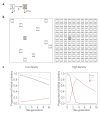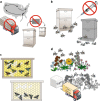Ecological and evolutionary approaches to managing honeybee disease
- PMID: 29046562
- PMCID: PMC5749923
- DOI: 10.1038/s41559-017-0246-z
Ecological and evolutionary approaches to managing honeybee disease
Erratum in
-
Publisher Correction: Ecological and evolutionary approaches to managing honeybee disease.Nat Ecol Evol. 2018 Jan;2(1):196. doi: 10.1038/s41559-017-0394-1. Nat Ecol Evol. 2018. PMID: 29203925 Free PMC article.
Abstract
Honeybee declines are a serious threat to global agricultural security and productivity. Although multiple factors contribute to these declines, parasites are a key driver. Disease problems in honeybees have intensified in recent years, despite increasing attention to addressing them. Here we argue that we must focus on the principles of disease ecology and evolution to understand disease dynamics, assess the severity of disease threats, and control these threats via honeybee management. We cover the ecological context of honeybee disease, including both host and parasite factors driving current transmission dynamics, and then discuss evolutionary dynamics including how beekeeping management practices may drive selection for more virulent parasites. We then outline how ecological and evolutionary principles can guide disease mitigation in honeybees, including several practical management suggestions for addressing short- and long-term disease dynamics and consequences.
Conflict of interest statement
The authors declare no competing financial interests.
Figures





References
-
- Boecking O, Genersch E. Varroosis: the ongoing crisis in bee keeping. J. Consum. Protect. Food Safe. 2008;3:221–228. doi: 10.1007/s00003-008-0331-y. - DOI
-
- Wenner AM, Bushing WW. Varroa mite spread in the United States. Bee Cult. 1996;124:342–343.
-
- Pettis JS, Delaplane KS. Coordinated responses to honey bee decline in the USA. Apidologie. 2010;41:256–263. doi: 10.1051/apido/2010013. - DOI
Publication types
MeSH terms
Grants and funding
LinkOut - more resources
Full Text Sources
Other Literature Sources

